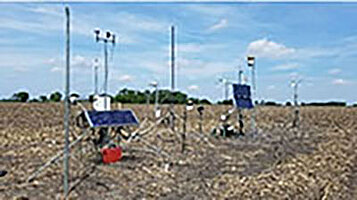Effect of Different Water Table Levels on Canola Growth and Quality Parameters

Ali Rashid Niaghi joined the Agricultural and Biosystems Engineering Department (ABEN) at North Dakota State University (NDSU) as a Ph.D. student in spring 2016. His major research advisor is Dr. Xinhua Jia and his supervisory committee members are Drs. Dean Steele and Thomas Scherer, ABEN, and Dr. Peter Oduor, Department of Geoscience. Ali is currently working on a United States Department of Agriculture, National Institute of Food and Agriculture (USDA-NIFA) funded project, “Managing water for increased resiliency of drained agricultural landscapes.” His research is aimed to develop crop coefficients for this region using precision instruments to measure the actual crop evapotranspiration.
Ali earned his undergraduate and M.Sc. degrees in agricultural engineering, with emphasis on irrigation and drainage from Tabriz University in Iran. His current research project involves water management, crop water requirement, subirrigation, drainage, and water quality. He believes utilizing new technologies in science and engineering with continuous and precise measurements could either solve the emerging problems or facilitate a solution. He has a strong desire to graduate with a Ph.D. degree in his area of interest and seeks a career in academia.
After joining Dr. Jia as a graduate student in January 2016, Ali worked with other team members on the installation and calibration of equipment, such as Bowen Ratio Energy Balance System, Eddy Covariance System, soil moisture sensors, wireless weather station, water level sensor, conductivity sensor, etc. He has been in charge of field activities, including data collection, sensor repair, and data processing. He is currently compiling results for second publication from one research field since the summer of 2016.Email: ali.rashidniaghi@ndsu.eduPhone: 701-936-2142
Assessing Effect of Precise Evapotranspiration Measurement on Crop Coefficient and Water Use
It is crucial to accurately measure the ETc from dominant vegetation surfaces in agricultural land management. Among different methods used to measure the ETc, above ground energy balance method is superior, especially in areas with shallow groundwater. In this project, corn ETc was measured using the near-surface energy balance with EC and BREB systems in a tile drained field. After analyzing the data during the growing season, the measured H with EC and the calculated latent heat flux (LE) using the residual method decreased with increasing the crop ground coverage. The results showed that the residual method was useful for closing the energy balance equation if the data were screened properly and the system was maintained in an acceptable condition. The diurnal analysis of H showed that the H measured by the EC and BREB agreed well with each other in July and August and similar in June and September, which resulted in a better estimation of LE and ETc. The developed Kc values using the EC system with the residual method can be as accurate as the result obtained from the BREB system. Therefore, they can be used for agricultural water management in the Red River Valley.
Peer-Reviewed Journal Papers:
Fidantemiz, Y.F., Jia, X., Daigh, A.L.M, Hatterman-Valenti, H., Steele, D.D., Niaghi, A.R., and Simsek, H. 2019. Effect of watertable depth on soybean water use, growth, and yield parameters. Water, 11(5), 931, doi: 10.3390/w11050931.
Niaghi, A.R., Jia, X., Scherer, T.F., and Steele, D.D. 2019. Measurement of non-irrigated turfgrass evapotranspiration rate in the Red River Valley. Vadose Zone Journal, doi: 10.2136/vzj2018.11.0202.
O’Brien, P.L., Acharya, U., Alghamadi, R., Niaghi, A.R., Sanyal, D., Wirtz, J., Daigh, A.L.M., and DeSutter, T.M. 2018. Hydromulch application to bare soil: soil temperature dynamics and evaporative fluxes. Agricultural and Environmental Letters Abstract-Research Letters, 3(1), doi:10.2134/ael2018.03.0014. source pollution in depression-dominated basins under varying hydroclimatic conditions. International Journal of Environmental Research and Public Health, 15, 2492, 1-17, doi:10.3390/ijerph15112492.
Conference/Seminar Presentations:
Fidantemiz, Y.F., Jia, X., Daigh, A.L., Hatterman-Valenti, H., Steele, D.D., Niaghi, A.R., Simsek, H. 2018. Effect of different water table levels on soybean water use and growth parameters. ICSAE 2018 5th International Conference on Sustainable Agriculture and Environment, Oct. 8-10, Hammamet, Tunisia.
Fidantemiz, Y.F., Steele, D.D., Jia, X., Tuscherer, S., Niaghi A.R., Simsek, H. (2018). Laboratory performance of three commercial soil moisture sensors. 1st Annual Gamma Sigma Delta, North Dakota State University Chapter Faculty and Student Symposium, April 12, 2018, Fargo, North Dakota.
Posters
Niaghi, A.R., and Jia, X. 2018. Assessing various evapotranspiration measurement methods for crop water management. 1st NDWRRI Special Water Resources Seminar. North Dakota State University, Fargo, ND (Oral Presentation).
Niaghi, A.R., and Jia, X. 2018. Evapotranspiration rate and energy flux comparisons of eddy covariance and Bowen ratio methods in the Red River Valley. ASABE Annual Meeting. July 31, 2018, Detroit, MI.
Niaghi, A.R., Jia, X., Scherer, T.F., and Steele, D.D. 2018. Effect of controlled drainage and subirrigation on corn evapotranspiration. Transforming Drainage Meeting, April 2018, Raleigh, NC.


Xinhua Jia, P.E., Professor
Morrill Hall Room 204
Department of Agricultural and Biosystems Engineering
North Dakota State University
NDSU Dept. 7620PO Box 6050
Fargo ND 58108-6050
Phone: (701) 231-6453
E-mail: xinhua.jia@ndsu.edu


